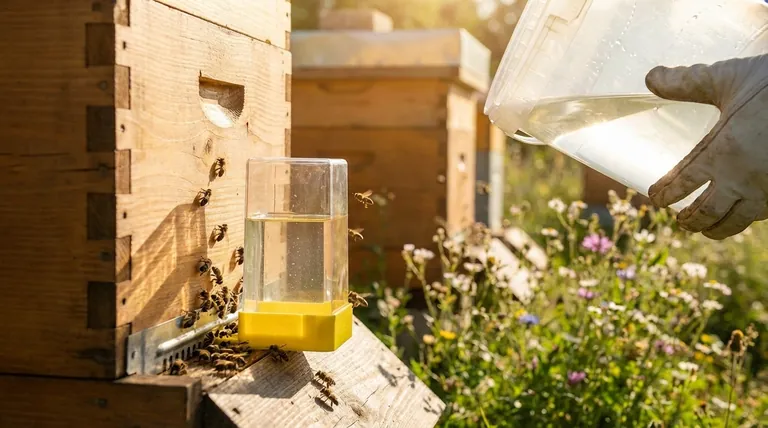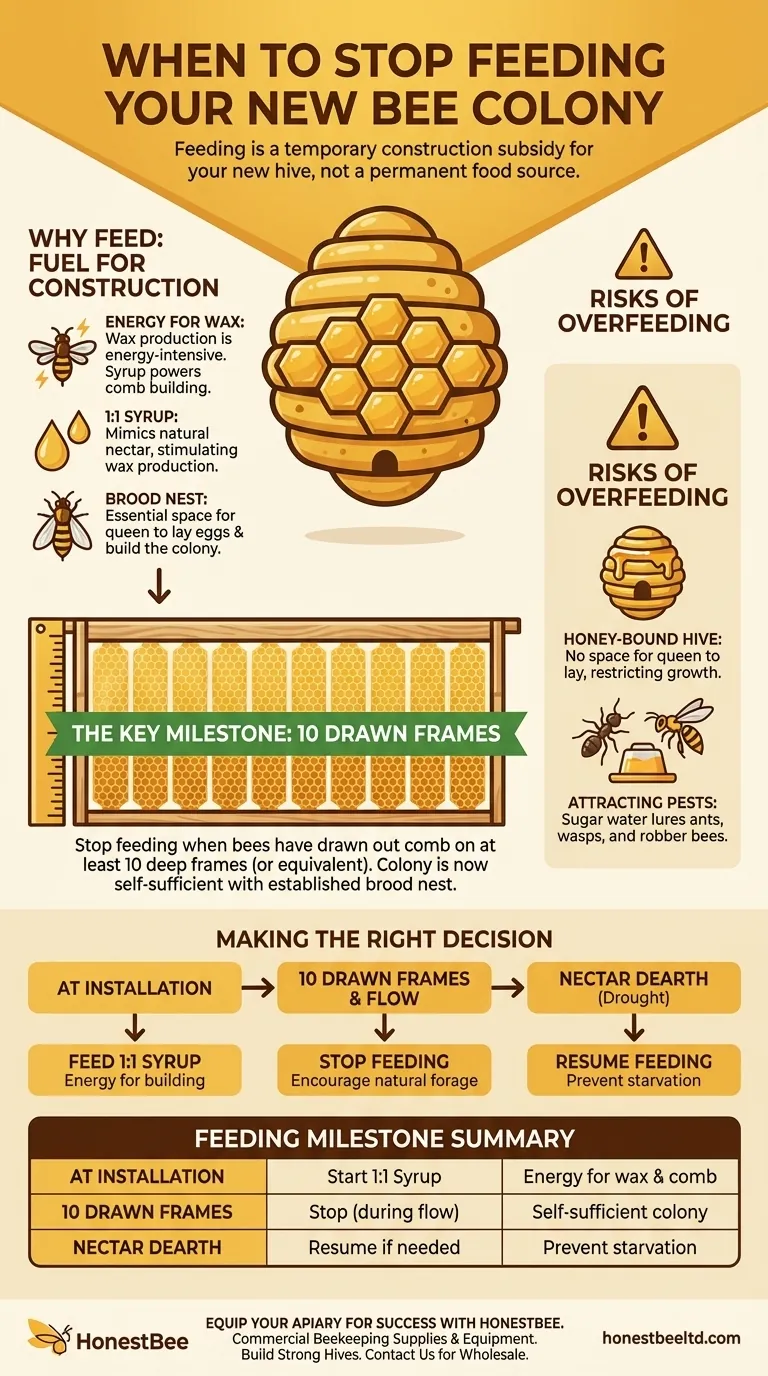As a new beekeeper, you should continue feeding your newly installed bee package a 1:1 sugar-water solution until they have built out, or "drawn," the honeycomb on at least ten deep frames or top bars. This initial feeding is not about long-term food storage; it is a critical fuel source that powers the massive construction project of building a functional hive from scratch.
Feeding a new colony is a temporary construction subsidy. Your goal is to provide the energy required for the bees to build their home and brood nest, then transition them to natural forage as quickly as possible to avoid dependency.

Why New Colonies Need Feeding: Fuel for Construction
A new package of bees is essentially a homeless, resource-less cluster of insects. They have a queen and workers, but no home, no pantry, and no nursery. Your initial feeding directly addresses this challenge.
The Energetic Cost of Wax
Producing beeswax is one of the most energy-intensive tasks a honeybee performs. Bees must consume large amounts of sugar (nectar or syrup) to activate the wax glands on their abdomens and secrete the tiny wax flakes used to build comb. Without a steady, abundant source of carbohydrates, wax production grinds to a halt.
The Purpose of 1:1 Syrup
A syrup solution of one part sugar to one part water (by weight or volume) closely mimics the consistency of natural spring nectar. This specific ratio stimulates the bees' instinct to produce wax and build comb, which is your primary goal after installation.
The True Goal: Building a Brood Nest
The initial drawn-out comb is not for honey. It is essential space for the queen to begin laying eggs. A productive queen can lay over 1,500 eggs per day, and she needs empty, clean cells to do so. This initial brood is the next generation of workers who will forage, defend the hive, and care for the queen, securing the colony's future.
The Key Milestone: When to Stop Feeding
Knowing when to stop is just as important as knowing when to start. The colony's progress, not the calendar, should be your guide.
The "10 Drawn Bars" Rule
The most reliable indicator for stopping is when the bees have fully drawn out the wax foundation on at least ten deep frames (or their equivalent in a different hive style). This signifies that they have established a large enough brood nest and have some initial cells for storing incoming nectar.
Why This Milestone Matters
Reaching this stage indicates the colony has likely achieved a critical mass of young bees and has enough established infrastructure to begin foraging effectively. Once they can bring in more nectar than they consume, they become self-sufficient, assuming a natural nectar flow is available.
Understanding the Trade-offs and Risks
While essential, supplemental feeding is an unnatural intervention with potential downsides if done improperly or for too long.
Risk 1: Creating a "Honey-Bound" Hive
If you continue feeding long after the brood nest is established, the bees will fill every available cell with sugar syrup. This can create a "honey-bound" condition where the queen runs out of space to lay eggs, severely restricting colony growth.
Risk 2: Attracting Pests and Robbers
The smell of sugar water is a powerful attractant. Spilled syrup or poorly designed feeders can quickly lead to an invasion of ants, wasps, or—most destructively—robber bees from neighboring hives who will fight to steal the resources.
The Importance of Feeder Hygiene
Always keep your feeders and the surrounding area impeccably clean, as stated in the references. Remove and clean feeders promptly once the colony is self-sufficient. Any mess signals a free meal to unwanted pests and neighboring hives, creating unnecessary stress on your new colony.
Making the Right Decision for Your Hive
Your role is to observe the colony's progress and adapt your feeding strategy to meet its needs. Use these guidelines to make a confident decision.
- If you just installed a new bee package or nuc: Feed a 1:1 sugar syrup continuously until they have fully drawn out at least ten deep frames.
- If your bees have met the 10-frame milestone during a strong nectar flow: Stop feeding completely to encourage them to forage on natural sources and prevent the hive from becoming honey-bound.
- If you are in a period of nectar dearth (drought or poor weather): You may need to resume feeding to prevent starvation, even after the hive is established.
By understanding the purpose behind feeding, you can confidently guide your new colony from dependency to a thriving, self-sufficient hive.
Summary Table:
| Feeding Milestone | Action | Key Reason |
|---|---|---|
| At Installation | Start feeding 1:1 sugar syrup. | Provides energy for wax production and comb building. |
| 10 Drawn Frames | Stop feeding (during nectar flow). | Colony is self-sufficient with established brood nest. |
| Nectar Dearth | Resume feeding if needed. | Prevents starvation when natural forage is unavailable. |
Equip your apiary for success with HONESTBEE.
As a commercial beekeeper or distributor, efficient colony establishment is key to your operation's productivity and profitability. Proper feeding is just one part of the equation; having the right, high-quality equipment is fundamental.
HONESTBEE supplies durable, reliable beekeeping supplies and equipment in bulk, tailored for the demands of commercial apiaries and distributors. From feeders and hive components to protective gear, we help you build strong, thriving hives from the start.
Contact our wholesale team today to discuss your needs and discover how our products can support the scale and success of your beekeeping business.
Visual Guide

Related Products
- Professional Hive Front Entrance Bee Feeder
- HONESTBEE Round Hive Top Bee Feeder for Syrup
- Classic Boardman Entrance Bee Feeder Hive Front Feeding Solution
- HONESTBEE Entrance Bee Feeder Professional Hive Nutrition Solution for Beekeeping
- Boardman Entrance Bee Feeder Durable Galvanized Steel and Wood Construction for Beekeeping
People Also Ask
- How does a beehive entrance feeder work? A Simple Guide to Supplemental Feeding
- How does the entrance feeder method work? A Guide to Simple But Risky Hive Feeding
- How do you make an entrance feeder for bees? A Guide to Safe & Effective Hive Feeding
- How to make an entrance feeder for bees? A DIY Guide for Safe & Effective Feeding
- What is an entrance feeder and how is it used? Avoid the Critical Risk of Robbing



















